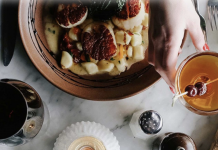
Photography Terry Brennan, Food Styling Lara Miklasevics
Chocolate. That word got your attention, didn’t it? Chocolate offers magical deliciousness that is hard to resist. In honor of National Chocolate Cake Day, which falls on January 27, it’s the perfect time to take a closer look at this celebrated food with fun facts to boost your chocolate knowledge and delicious recipes to boost your mood.
Many foods make the news when a study comes out that extols their health virtues. Then a different study might suggest that particular food is not as good for us as we once thought. But for thousands of years, people seem to have known instinctively that there was something magical about chocolate. Before modern science bandied about words such as “antioxidants” or “polyphenols” that have now reinforced our love of the food, people around the world have turned to chocolate to cure sickness, appease gods, show love, buy animals, celebrate holidays and sustain warriors.
Humans’ fascination with chocolate began at least 4,000 years ago in present-day southern Mexico and Central America where cacao (ka-kow) trees grew wild, according to the National Confectioners Association (NCA). When these early people unlocked the secret of how to eat the bitter seed from the fruit of this tree they launched an enduring love affair.
The trees grow in the tropics, primarily in remote areas of West Africa, Southeast Asia and Central and South America. Like wine, chocolate reflects the distinct flavors of its region. Beans from Trinidad, for example, could have a cinnamon spiciness while those from Ecuador have a floral quality, and beans from Jamaica might even have a hint of pineapple.
Dark Versus Milk Chocolate
Chocolate is simply chocolate liquor (the centers of cocoa beans ground to a liquid), extra cocoa butter, sugar, an emulsifier (often lecithin) and vanilla or other flavorings. Dark chocolates may contain milk fat to soften the texture but do not generally have a milky flavor. Dark chocolate also is known as semi-sweet chocolate. Unsweetened chocolate, or baking chocolate, is 100 percent chocolate liquor and is typically very bitter and astringent. Milk chocolate contains all of the ingredients found in dark chocolate plus milk solids, which are usually dry and look like powdered milk, rather than the liquid milk we drink.
When selecting chocolate, the “% cacao” on packages refers to the percentage of cacao bean solids in the bar. The higher the percentage of cacao, the less sweet the bar and the stronger the chocolate taste. Milk chocolate has at least 10 percent cocoa liquor by weight, and at least 12 percent milk solids.
What is Dutch-process cocoa powder?
Both Dutch-process and natural cocoa powders are made from dried and roasted cocoa beans that have been ground into a powder. The difference is in how they are processed. Dutch-process cocoa powder has been rinsed with a potassium carbonate solution, which neutralizes cocoa’s natural acidity. Dutch-process cocoa is darker and has a richer and smoother chocolate flavor. Since natural cocoa powder has not been alkalized, it is more acidic and has a lighter color. The two cocoa powders are not usually interchangeable in recipes.
Magical and Delicious
Now, through modern science, we know chocolate really is good for our health—in moderation, of course. Dark chocolate (65 percent or higher cocoa content) provides more antioxidants than milk chocolate, and is high in manganese, copper, iron, and magnesium. Antioxidants may help reduce LDL cholesterol, lower blood pressure, improve blood flow and reduce blood clotting—all that in addition to chocolate’s magical deliciousness.
Chocolate Pomegranate Cupcakes with White Chocolate Mousse Frosting
Makes 12 cupcakes
In this recipe by baking expert and cookbook author Elinor Klivans, which appeared in Real Food, antioxidant-rich pomegranate juice adds a twist. White chocolate and whipped cream produce the mousse topping and pomegranate seeds the final flourish. It only takes 3 ingredients to make the mousse: white chocolate, heavy cream, and vanilla. The quick trick of stirring a portion of whipped cream into the melted white chocolate blends the cold and warm ingredients without forming any hard bits of white chocolate, says Klivans.
Cupcakes
1 cup all-purpose flour
¼ cup unsweetened Dutch process cocoa powder
½ teaspoon baking soda
¼ teaspoon salt
4 tablespoons (½ stick) unsalted butter, at room temperature
1 cup sugar
2 large eggs
1 teaspoon vanilla extract
²⁄3 cup pomegranate juice
Frosting
8 ounces white chocolate, chopped
2 cups heavy cream, cold
1 teaspoon vanilla
seeds from 1 pomegranate (about ¹⁄3 cup)
- Position a rack in middle of oven and preheat to 325°F. Line 12 muffin-tin cups with paper cupcake liners.
- For cupcakes: Sift flour, cocoa powder, baking soda, and salt into a medium bowl and set aside.
- In a large bowl and using an electric mixer on medium, beat butter and sugar until blended, 1 minute. Add eggs 1 at a time, beating until each is blended into batter. Mix in vanilla and beat 1 minute. With mixer on low, mix in half of flour mixture, just to incorporate. Mix in pomegranate juice to blend. Mix in remaining flour mixture until incorporated and mixture looks smooth.
- Fill each paper liner with about ¼ cup batter (an ice cream scoop works well). Bake just until tops feel firm and a toothpick inserted in center comes out clean, about 25 minutes. Cool 10 minutes in pan on a wire rack. Remove from pan onto wire rack and let cool completely.
- For frosting: Put chocolate in a heatproof container or top of a double boiler and place over, but not touching, a saucepan of barely simmering water. Stir mixture over hot water until chocolate melts. Scrape melted chocolate into a large bowl to cool slightly.
- In a large bowl and using an electric mixer on medium-high, beat cream and vanilla until firm peaks form. Whisk about one-third of whipped cream into chocolate until smoothly blended, about 30 seconds. Fold in remaining whipped cream. Spread mousse over top of each cupcake, mounding it to center. Sprinkle pomegranate seeds over top of each before serving. Cupcakes can be covered and refrigerated overnight, but bring to room temperature about 15 minutes before serving.
Cake Tips
Improve your cake-making skills with these tips from Elinor Klivans:
• Leaving a cake in its pan for 10 to 15 minutes after baking gives it time to settle and firm slightly. This creates a more stable cake that is easily removed from the pan.
• A thin, metal spatula is the best tool for spreading frosting smoothly over a cake. Some soft cakes begin to crumble when a frosting or glaze is spread on them. To prevent cake crumbs from becoming mixed in with the outer layer of frosting or glaze, use a “crumb coat”—a thin layer of frosting or glaze spread over the outside of the cake before the final, thick layer of frosting or glaze is added.
Nutrition info Chocolate Pomegranate Cupcakes with White Chocolate Frosting (per serving): Calories 395 (208 from Fat); Fat 24g (Sat. 14g); Chol 89mg; Sodium 146mg; Carb 43g; Fiber 2g; Protein 5g

Photography Terry Brennan, Food Styling Lara Miklasevics
Hungry for More?
Check out these decadent chocolate cake recipes I have highlighted on this site. Some were posted around the holidays, but no matter the holiday-centric theme—delicious chocolate cakes are a welcome treat anytime:
Chocolate and Cranberry Layer Cake with White Chocolate Truffle Glaze
This is a special cake that can serve a crowd—not to mention, it’s chocolate.
Dark Chocolate Ripple Pound Cake
Share the love this Valentine’s Day or anytime with an easy-to-make yet indulgent chocolate cake.
Chocolate Whiskey Cake
Nothing says “festive” like homemade chocolate cake—and a spirited version ramps up the festive factor.
Fudge on Fudge Peppermint Ice Cream Cake
This cake is like a giant refreshing after-dinner mint—plus it can be made ahead and ready when you are.
Hot Fudge Sundae Congo Cake
This loosely fits the “chocolate cake” category but it was a reader’s favorite birthday request. While this would be a welcome choice for a gathering, it doesn’t need to be anyone’s birthday or a special occasion to enjoy this chocolaty treat!






